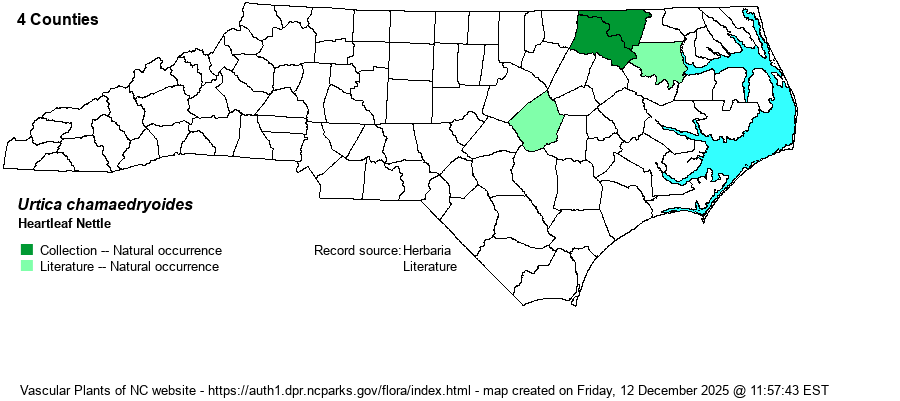| Author | Pursh | |
| Distribution | Limited to the Roanoke River floodplain, in Northampton, Halifax, and Bertie counties, and to be looked for in adjacent Martin County. There is a sight report from a vegetation plot in the Neuse River floodplain in the Coastal Plain portion of Johnston County -- hopefully correct.
This is a Southern species, primarily found from central TN and OK southward; sparingly and locally east to northeastern NC and central FL. The NC records are well disjunct from sites in central SC. | |
| Abundance | Along the Roanoke River, it is locally common in the upper half of the floodplain, with about 15-16 sites known; extremely rare elsewhere in the state, with just the single other report. This is a State Threatened species, owing to the large range disjunction from SC to the Roanoke River. | |
| Habitat | This species requires high pH soil, in rich alluvium derived from weathering of mafic rocks farther upriver. It grows essentially on natural levee forests of brownwater rivers, less so farther back from the river edge on ridges within the floodplain. |
| Phenology | Blooms from September into May, often during the winter season; fruits about two months after flowering. | |
| Identification | This is a quite distinctive species with stinging hairs on the stems, as in Laportea canadensis. The plants are usually branched from the base, but each stem is wand-like, usually leaning on other vegetation, and about 3 feet long. The leaves are small/short for the height of the plant, being nearly sessile and ovate in shape, only about 1-1.5 inches long and about 3/4-inch wide, with numerous teeth on the margins. The leaf base is cordate to nearly truncate; a few stinging hairs are present on the blades. The flowers are in very short clusters in leaf axils, barely longer than the petioles. The species grows in dense clumps, as do many other members in the nettle family (Urticaceae). | |
| Taxonomic Comments | This species was not known from NC when RAB (1968) was published; surprisingly, the authors and other early botanists neglected the very rich slopes and floodplain of the Roanoke River, as a number of species that are actually locally common there were not reported in this reference.
| |
| Other Common Name(s) | None | |
| State Rank | S2 | |
| Global Rank | G4G5 | |
| State Status | T | |
| US Status | | |
| USACE-agcp | FAC link |
| USACE-emp | FACU link |

